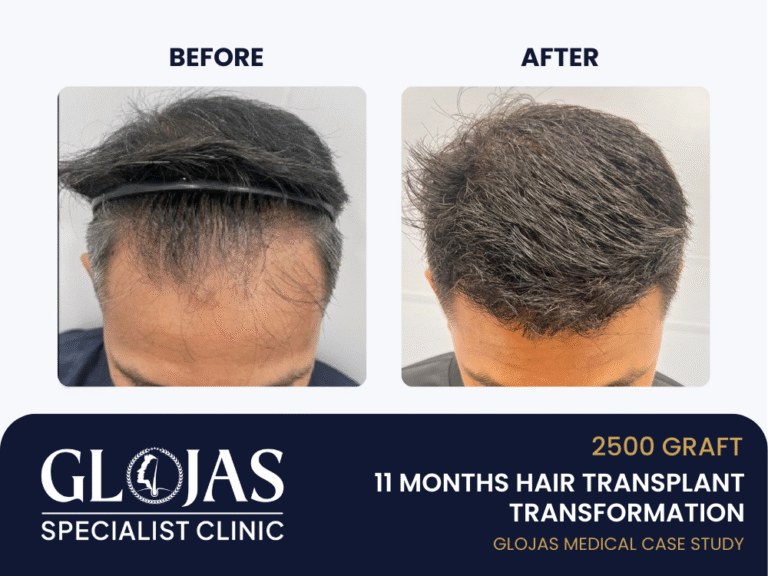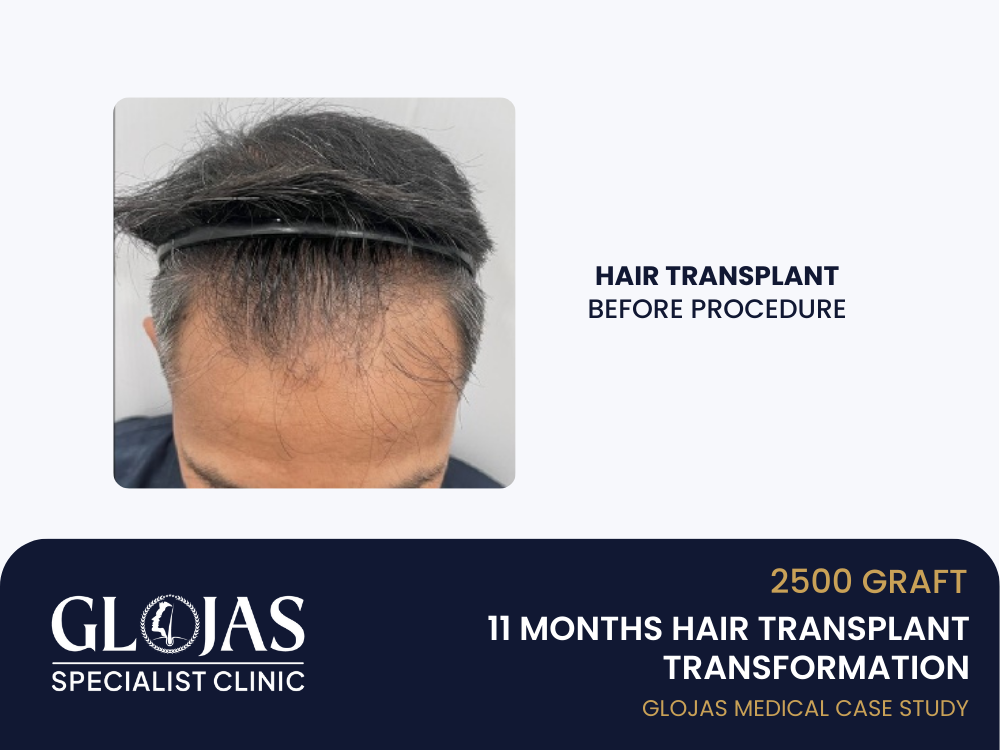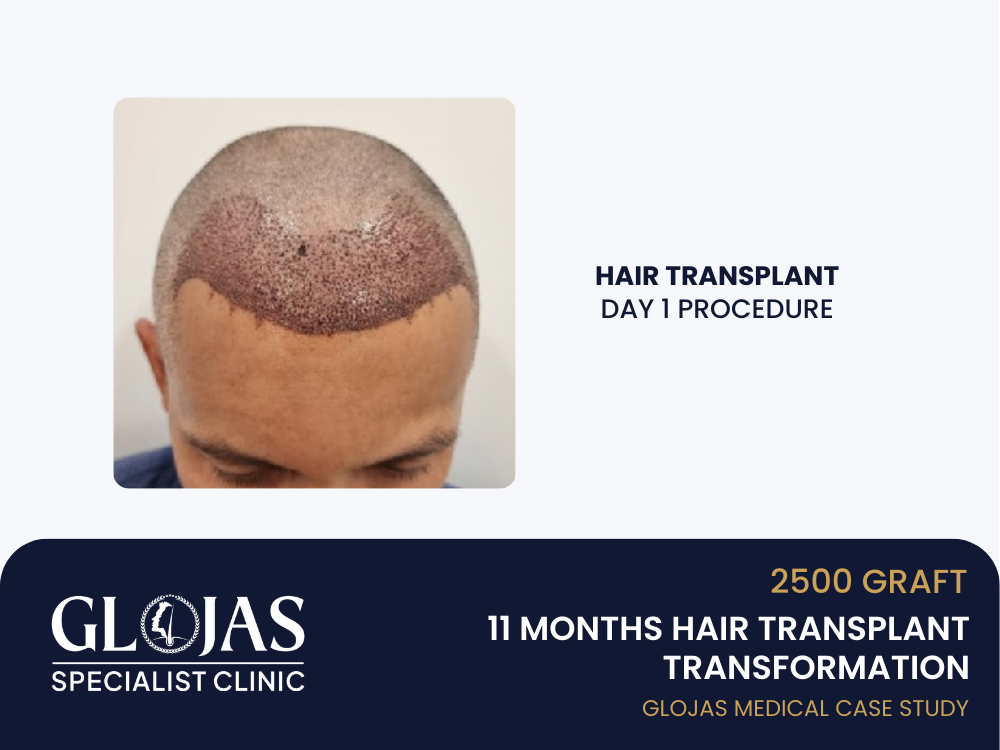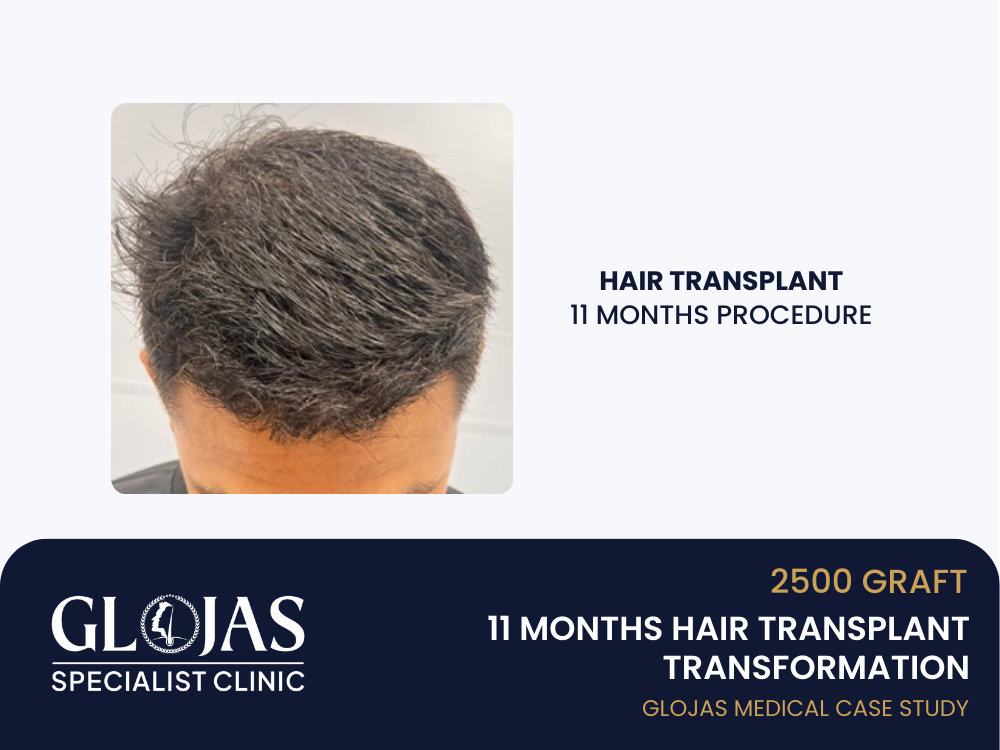Hair loss affects millions of men worldwide, and one of the most common patterns is Norwood Type 3, where baldness begins at the frontal hairline, vertex, and crown. While medications like finasteride or minoxidil may slow hair fall, they often fall short in reversing baldness.
This case study follows this patient who opted for a SMART™ FUE hair transplant, using 2,500 grafts to restore density across the front, vertex, and crown. His transformation over 11 months reveals just how effective this modern, minimally invasive technique can be.
Patient Background
Name: Mr. R (identity protected)
Age: 35
Hair Loss Classification: Norwood Type 3 Vertex
Main Concern: Balding at the front, vertex thinning, crown fully exposed
Hair Characteristics: Straight, thick, black hair
Donor Zone: Occipital and parietal regions of the scalp
Mr. R had tried topical treatments for years without improvement. He was frustrated with his thinning crown and receding hairline, which made him look older than he felt.
Consultation & Treatment Plan – Hair Transplant
At the initial consultation, Mr. R underwent a scalp and follicle density analysis, and a personalized digital simulation was created to visualize realistic expectations.
Diagnosis:
Recession at bilateral temples
Vertex density reduced to <30 grafts/cm²
Crown completely bald
Donor area: healthy with >85 grafts/cm² density
Proposed Plan:
2,500 grafts total
1,200 for frontal restoration
800 for vertex reinforcement
500 for crown coverage
Hairline design: natural curve with slight temporal recession for age-appropriateness
Target density: 35–45 grafts/cm² for visible improvement
Why SMART™ FUE?
SMART™ FUE (Scalp Micro-Advanced Restoration Technique) offers higher precision, lower trauma, and faster recovery than traditional FUE methods. Key benefits include:
Up to 95% graft survival rate
Micro-sized punch extraction (0.7–0.9mm)
Custom implanters for natural angulation
Minimal scarring and post-op discomfort
Best suited for multi-zone transplants (frontal + crown)
Procedure Summary
Mr. R underwent the transplant over two sessions in one day, with a total duration of around 8 hours.
Step-by-step:
Hairline mapping and zone marking
Donor extraction: 2,500 grafts from occipital/parietal areas
Graft preparation: Sorted by units (1, 2, 3 hairs)
Recipient site creation: Sapphire blades are used to minimize tissue trauma
Implantation: Angled to match native growth patterns
Post-op wrap-up: Scalp cleaning & aftercare briefing
Recovery & Post-Op
Day 1–3: Minor swelling at the forehead, light redness on the recipient area
Day 4–7: Formation of scabs — instructed to use saline spray and avoid scratching
Week 3–4: Shock loss began (normal follicle shedding phase)
Months 2–3: Dormant phase – little visible change
Month 4 onward: Steady regrowth began, visible in the vertex and crown
Month 11: Full visible outcome
11-Month Results
At his 11-month follow-up, Mr. R’s results exceeded expectations:
| Zone | Before Transplant | After 11 Months |
|---|---|---|
| Frontal Hairline | Deep temporal recession | Restored, youthful contour |
| Vertex | Diffuse thinning | Filled with strong density |
| Crown | Fully bald | 80% coverage, seamless blend |
| Confidence | Low | Highly changed grooming routine |
Photos confirmed dense, even growth across all treated areas. The frontal hairline looked natural, while the crown and vertex no longer showed scalp exposure.
Patient Feedback
“I never imagined I could have a full hairline again. People say I look 10 years younger. Best decision I ever made.”
Mr. R resumed styling and even changed his haircut to suit the new volume. No signs of patchiness or visible scarring were present.
Maintenance & Care Moving Forward
Mr. R continues a mild DHT-blocking shampoo routine
No need for oral finasteride (doctor-approved)
Routine follow-ups are scheduled every 6–12 months
5 Frequently Asked Questions (FAQ)
1. Can SMART™ FUE cover both hairline and crown in one session?
✅ Yes. With enough donor density, SMART™ FUE can strategically divide grafts between multiple zones — frontal, vertex, and crown — in a single session.
2. Will the transplanted hair fall out later in life?
No. The transplanted hair is from the DHT-resistant donor zone, which continues to grow naturally for life.
3. How long does full recovery take?
Most healing happens within 7–10 days. Visible growth starts at month 4, and full results are seen by 9–12 months.
4. Is the crown area harder to restore than the front?
Yes. Due to hair swirl patterns, the crown requires more grafts for visual density. SMART™ FUE helps overcome this by precise graft angling.
5. Will the result look natural?
Absolutely. With proper angling, spacing, and technique, SMART™ FUE results are undetectable — even by close inspection.
Final Thoughts
This case illustrates how 2,500 grafts using SMART™ FUE can deliver complete transformation across multiple scalp zones, even in advanced Norwood Type 3 baldness.
At just 11 months, Mr. R regained his hairline, filled in his crown, and restored his self-esteem, without scars or artificial appearance.
If you’re dealing with hair loss in multiple areas, SMART™ FUE offers a scientifically advanced, permanent solution worth considering.




